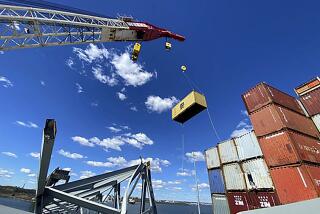Divers Remove 3rd Steel Plate Dangling From Hull of Valdez
- Share via
Divers working underneath the Exxon Valdez on Sunday removed a third massive steel plate dangling from the oil tanker’s hull, and worked to cut away several others while seas off San Clemente Island were calm.
The salvage team, fearing that an earlier plan to catch the plates as they fell was too dangerous, allowed the plates to drop to the ocean floor, and Exxon Shipping Co. officials say they are uncertain whether any of the pieces will be retrieved.
The plates, which peeled back from the hull during the Valdez’s 2,200-mile trip from Alaska, prevent the tanker from clearing the bottom of San Diego Bay, where it is scheduled to dry-dock for repairs.
Meanwhile, the state and Exxon completed negotiations of conditions that would allow the ship into state waters, but are reviewing final drafts before declaring it an agreement, officials said.
The salvage crew Saturday cut off the largest of seven plates jutting downward from the hull, a piece about 70 feet long and 68 feet wide that weighs about 50 tons, officials said.
The first plate, an 11-ton piece measuring 32 by 15 feet, came off late Friday, and the remaining four smaller pieces are expected to be removed during the next three to four days, said Jan Cool, a spokeswoman for Exxon Shipping.
“The plan is that they will work as quickly as they can, within conditions of maximum safety,” Cool said.
The vessel on Sunday was drifting 4 to 6 miles off San Clemente Island, amid swells of up to 2 feet.
Divers lay on their stomachs inside the ship’s open tanks to cut the plates, which dropped about 3,000 feet to the ocean floor, Cool said.
Originally, divers planned to attach cables to the plates, cut them away bit by bit and transfer the pieces to a salvage barge.
But concern that the divers’ air and equipment hoses, which stem from the ship itself, could become tangled with the cables led to the decision to allow the plates to drop, Cool said.
The U.S. Coast Guard, which has jurisdiction over the federal waters in which the ship is drifting, authorized the decision, and is monitoring the location of the plates, she said.
“It was determined that we could not, because of sea conditions, safely remove those plates and catch them and yet protect the divers, too,” Cool said. “It’s quite a dangerous situation.”
She said it is unlikely that Exxon will retrieve the largest plates, because of the danger posed to divers, but that smaller pieces might be collected later.
“There’s really no reason why there should be any concern about dropping these plates, from an environmental standpoint,” she said. “But we will recover the ones we can recover safely.”
The Valdez was towed from Alaska after hitting a reef there March 24 and causing the nation’s worst oil spill, along the Prince William Sound shoreline. The ship was scheduled to enter San Diego Bay on July 11 for repairs at National Steel and Shipbuilding Co., which built the vessel in 1986.
But the discovery July 10 of the jutting plates, as well as the slicks and discharges, delayed its entry.
More to Read
Sign up for Essential California
The most important California stories and recommendations in your inbox every morning.
You may occasionally receive promotional content from the Los Angeles Times.













